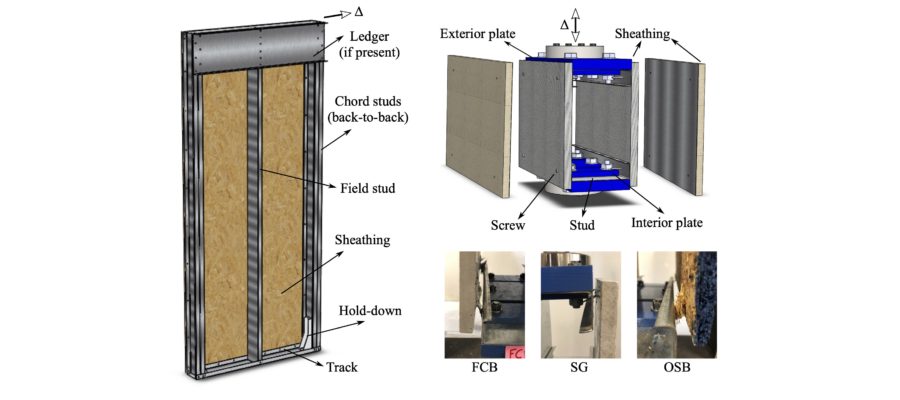Cold-formed steel (CFS) can be used for both structural and non-structural building systems, including as the designated lateral force resisting system. CFS shear walls, braced or sheathed, act as the most common lateral load resisting systems. The objective of this work is to numerically assess the performance of sheathed CFS shear walls subjected to earthquake and wind events.
A robust three-dimensional high-fidelity shell finite element model is developed, and aims to provide a benchmark modeling approach able to accurately capture strength, stiffness and failure mechanisms in oriented strand board (OSB) sheathed CFS shear walls. The computational method includes shell elements for both CFS components and sheathing, orthotropic OSB modeling for sheathing material, linear springs for the simulation of hold downs and nonlinear connector elements to represent the CFS-to-sheathing connections. Particular attention is given to the fundamental role of the connections between the CFS members and the OSB sheathing to the overall shear wall lateral response. To understand variability in this critical connection a series of 30 identical connection tests are performed. The robustness of the proposed computational model is validated by nine different OSB-sheathed CFS shear wall experimental studies and by a parametric analysis.
To expand the knowledge and breadth of design options of CFS construction into higher capacity lateral force resisting systems, the proposed finite element model is adopted for CFS shear walls sheathed with fiber cement board (FCB) and composite steel-gypsum (SG) panels. An experimental program of monotonic and cyclic fastener testing was conducted to provide shear response of CFS-to-sheathing connections with various sheathings (FCB, SG), screws, and screw spacing. Monotonic connection means are derived from the experiments and introduced in the finite element model. The numerical results demonstrate significant capacity benefits and different failure modes from traditional OSB-sheathed shear walls. As fastener spacing is decreased, failure mode shifts from fastener-dominant to the steel framing itself. To enable adoption by practitioners, prescriptive design recommendations are provided. As the developed finite element model is computationally expensive, Pinching4 parameters from the cyclic testing are also provided to aid in the development of reduced-orders models.
This work not only aims to provide an innovative and accurate computational tool for OSB-, FCB- and SG-sheathed CFS shear walls to the research community, but also to expand CFS practice through higher capacity design options. Furthermore, the computational model is intended for a potential use in the full CFS-NHERI building capacity prediction and design.
This post was prepared by CFS-NHERI researcher and Ph.D. candidate at UMass-Amherst, Fani Derveni. Contact cfsrc “at” cfsrc.org or Ms. Derveni for further information.

